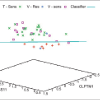Abstract
Purpose
This study was designed to identify genes that could predict response to doxorubicin-based primary chemotherapy in breast cancer patients.
Experimental Design
Biopsy samples were obtained before primary treatment with doxorubicin and cyclophosphamide. RNA was extracted and amplified and gene expression was analyzed using cDNA microarrays.
Results
Response to chemotherapy was evaluated in 51 patients, and based on Response Evaluation Criteria in Solid Tumors guidelines, 42 patients, who presented at least a partial response (≥30% reduction in tumor dimension), were classified as responsive. Gene profile of samples, divided into training set (n = 38) and independent validation set (n = 13), were at first analyzed against a cDNA microarray platform containing 692 genes. Unsupervised clustering could not separate responders from nonresponders. A classifier was identified comprising EMILIN1, FAM14B, and PBEF, which however could not correctly classify samples included in the validation set. Our next step was to analyze gene profile in a more comprehensive cDNA microarray platform, containing 4,608 open reading frame expressed sequence tags. Seven samples of the initial training set (all responder patients) could not be analyzed. Unsupervised clustering could correctly group all the resistant samples as well as at least 85% of the sensitive samples. Additionally, a classifier, including PRSS11, MTSS1, and CLPTM1, could correctly distinguish 95.4% of the 44 samples analyzed, with only two misclassifications, one sensitive sample and one resistant tumor. The robustness of this classifier is 2.5 greater than the first one.
Conclusion
A trio of genes might potentially distinguish doxorubicin-responsive from nonresponsive tumors, but further validation by a larger number of samples is still needed.
